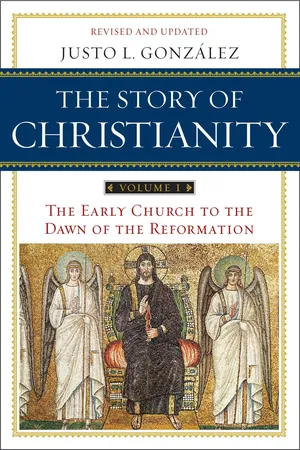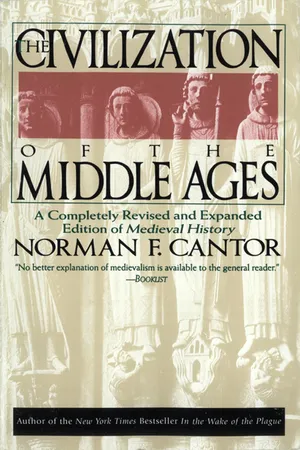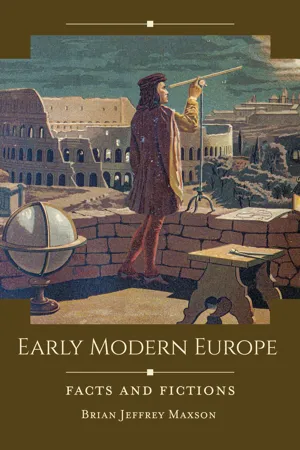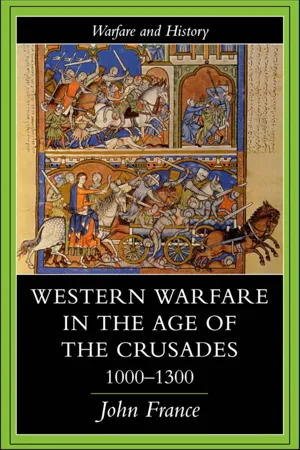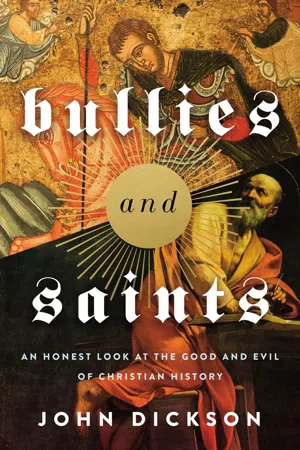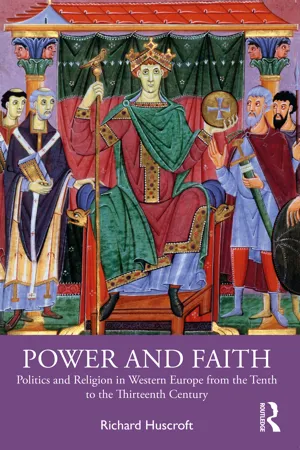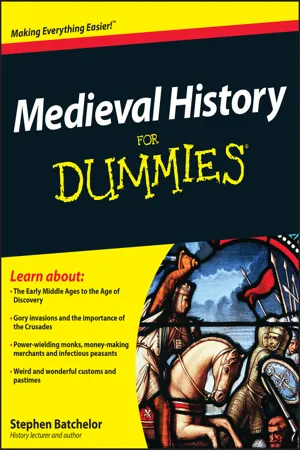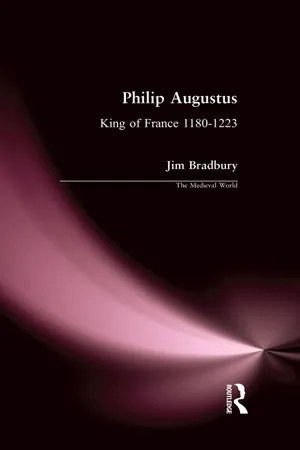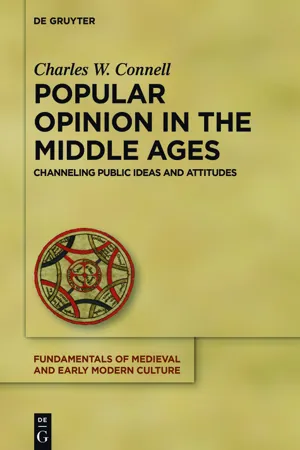History
Third Crusade
The Third Crusade was a major military campaign initiated by European leaders in response to the fall of Jerusalem to Saladin in 1187. Led by prominent figures such as Richard the Lionheart of England, Philip II of France, and Holy Roman Emperor Frederick I, the crusade aimed to recapture the Holy Land. Despite some successes, the campaign ultimately ended without achieving its primary objective.
Written by Perlego with AI-assistance
Related key terms
10 Key excerpts on "Third Crusade"
- eBook - ePub
The Story of Christianity: Volume 1
The Early Church to the Dawn of the Reformation
- Justo L. Gonzalez(Author)
- 2014(Publication Date)
- HarperOne(Publisher)
Since the crusading spirit, and crusading columns, were a constant feature for centuries, it is not altogether correct to speak of the “Crusades” as a series of isolated campaigns. But there were high points in the entire enterprise, which are usually referred to as the “Second Crusade,” the “Third Crusade,” and so on. An outline of these will show some of the subsequent course of the crusading spirit.The occasion for the Second Crusade was the Fall of Edessa, taken by the Sultan of Aleppo in 1144. Once again, popular preachers arose who called for the masses to invade the Holy Land. Along the way, some also said, Jews should be exterminated. The preaching of Bernard of Clairvaux was very different, for it sought both to organize an army of relief for the Kingdom of Jerusalem, and to refute the fiery preaching of those who advocated a mad rush to Jerusalem. Finally, under the leadership of Louis VII of France and Conrad III of Germany, an army of almost two hundred thousand left for the Holy Land. They were repeatedly defeated by the Turks, and accomplished little.For a while the kingdom of Jerusalem grew strong, and under Amalric I it even extended as far as Cairo. But then the Muslims began to regroup and, under the leadership of the Sultan of Egypt, Saladin, took Jerusalem in 1187.The news shook Christendom, and Pope Clement III called for a renewal of the crusading enterprise. This Third Crusade was led by three sovereigns: Emperor Frederick Barbarossa, Richard the Lionhearted of England, and Philip II Augustus of France. This too failed. Frederick drowned, and his army dissolved. Richard and Philip achieved nothing but taking Acre after a siege that lasted two years. Philip then returned to Europe, hoping to take advantage of Richard’s absence to take some of the latter’s lands. Richard himself, on his way home, was captured by the emperor of Germany and kept a prisoner until an enormous ransom was promised.The Fourth Crusade, called by Innocent III, was an even greater disaster. Its goal was to attack Saladin at his headquarters in Egypt. A famous preacher, Foulques de Neuilly, was entrusted with the task of raising armies and funds for the Crusade. Foulques was a radical opponent of usury and all forms of social injustice who was incensed at the manner in which the developing monetary economy allowed the rich to use their money to become even richer, while the poor remained in poverty. In preaching the Crusade, Foulques declared that the poor were elected by God to fulfill this great task. All could participate in this project. Those who could not go on Crusade, no matter how poor, should support others who could. The rich must also join, for in so doing their exploitations were forgiven. Thus an army was raised eager to attack Saladin in his own capital. - eBook - ePub
Civilization of the Middle Ages
Completely Revised and Expanded Edition, A
- Norman F. Cantor(Author)
- 2015(Publication Date)
- Harper Paperbacks(Publisher)
The crusading ideal during the twelfth and thirteenth centuries was a popular outlet for the intense: and widespread piety of the period, but it was only one form among many. To the kings and princes of western Europe, taking the cross was a necessary duty encouraged by the pope and other important churchmen. It was something they had to do as an expression of their status in society and to appease public opinion, but nearly all of them took it as a formal matter that required only a small part of their energy and resources. The second crusade of 1144 was preached by St. Bernard of Clairvaux, the moral leader of the mid-twelfth-century church, in response to urgent entreaties from the Latin Kingdom of Jerusalem for aid against the resurgent Arabic power. St. Bernard succeeded in inducing two of the crowned heads of Europe, Louis VII of France and Conrad III of Germany, to take the cross. The inclusion of the two kings provided more prestige than the first crusade had enjoyed but no more military prowess, for Louis and Conrad were not renowned for their skill on the battlefield or the size of their armies. They never reached Palestine, their forces being cut to pieces in Asia Minor. The sole consequence of the second crusade was the strain it placed on the relations between Louis and his queen, Eleanor of Aquitaine, who accompanied him on the expedition and whom Louis accused of infidelity with one of his generals. The resulting divorce of the Capetian king and the duchess of Aquitaine and her subsequent marriage to Henry II of England had an important effect upon the political development of twelfth-century Europe. The mixture of tragedy and farce that characterized the second crusade was repeated in the Third Crusade of 1190, the most ambitious, at least in its inception, of all the Latin expeditions to the Holy Land. The power of Saladin was to be challenged by a crusading army that, at least on paper, commanded the greater part of the military resources of Europe - eBook - ePub
Early Modern Europe
Facts and Fictions
- Brian Jeffrey Maxson(Author)
- 2023(Publication Date)
- Bloomsbury Academic(Publisher)
9 The Crusades Ended in the Middle Ages What People Think HappenedIn 1095, Pope Urban II announced the First Crusade to knights at the Council of Clermont. The men in attendance raised their swords in jubilation. After some preparations, heavily armored men marched through Islamic lands before arriving at the doors of Jerusalem. Soon the city fell and the Holy Land returned to Christian hands. However, European successes did not last for long; and a series of distinct armies descended upon the Middle East from Europe. Today, these distinct armies are known as the numbered crusades. Some of them are still famous. In the Third Crusade, for example, King Richard of England fought against noble Saladin. Their mutual military brilliance made gains difficult on either side, but their stalemate led to a surprising, even unprecedented respect between the Christian king and the Islamic sultan. Back in England, Robin Hood helped ensure the well-being of the English and the security of Richard’s throne during the king’s absence.The myth goes that the Crusades consisted of nine distinct events spread out over a bit more than 200 years of history. Over time, it became clear that the land route from Europe to the Holy Land was not working. Thus, Crusaders began sailing to Egypt and then trying the shorter land passage to Jerusalem. These different Crusades often sought both to retake lands from Islam and to provide aid to the Crusader Kingdoms established after the First Crusade. Those Crusader Kingdoms were Christian bulwarks in Islamic lands. Each heavily fortified kingdom fought never-ending wars against bellicose people who simply viewed the world differently than they did. The fall of the last Christian outposts at Acre in 1291 ended the Crusades. From that point onward, Europeans lacked a foothold in the east. Additionally, their conflicts became simply different than the Crusades had been. During the Crusades, according to the myth, big armies had fought huge campaigns aimed at conquering the Holy Land. They had adopted the Cross as their symbol. They had fought for religious purposes. The myth goes that all of that ended in 1291. Armies stopped seeking the Holy Land or wearing the cross. A stalemate began between the Islamic East and the Christian West. - John France(Author)
- 2020(Publication Date)
- Routledge(Publisher)
Uncertain and often divided leadership was inevitably accompanied by uncertain purpose. Much of the success of the First Crusade was due to the limited but specific objective – Jerusalem. When its leaders were at their most ignorant and hesitant, their army was large enough to overcome by sheer weight of numbers the Sultanate of Nicaea. Very quickly, they took the measure of their enemies and maximized their strength by an adroit diplomacy, winning allies and buying off enemies by pacts of friendship which they were perfectly prepared to break. This diplomatic aspect to their crusade was vital, for although the Middle East was fragmented, many of its component parts were more than a match in military terms for the invaders. What the Muslim powers did not understand was that the invaders posed a threat to their very existence. Once that was understood, the scale and quality of their resistance to new crusades was enormously enhanced.The Second Crusade simply had no clear purpose: the occasion of its calling was the fall of Edessa to Zengi, but this had not in itself stirred the West; it was only the incredible activity of St Bernard that created what became a general onslaught upon the non-Catholics who confronted Europe. This vast concept never generated any central control and Louis VII, the only leader to arrive in Jerusalem with an army, had little idea what to do with it. Richard of England, as we have noted, had a crusading strategy – to seize Egypt, the real heart of Saladin’s power – but the religious goal of the expedition (and probably the personal animosity which Richard so obviously generated) proved too strong. But the problems of the Third Crusade were pondered. The union of Syria and Egypt under Saladin had caused the fall of the Latin Kingdom, but the quarrels of his descendants, the Ayyubids, created opportunities which could be exploited. The leaders of the Fourth Crusade made a secret decision to attack Egypt. This was actually carried out by the Fifth Crusade, probably acting in accord with the decisions of the Fourth Lateran Council, although it was their decision to attack Damietta rather than Alexandria. Once the city had fallen, the crusade was for long paralysed by failures of command, and it was probably popular demand for action that led to its ultimate failure near Mansourah.11- John France(Author)
- 2002(Publication Date)
- Routledge(Publisher)
Uncertain and often divided leadership was inevitably accompanied by uncertain purpose. Much of the success of the First Crusade was due to the limited but specific objective - Jerusalem. When its leaders were at their most ignorant and hesitant, their army was large enough to overcome by sheer weight of numbers the Sultanate of Nicaea. Very quickly, they took the measure of their enemies and maximized their strength by an adroit diplomacy, winning allies and buying off enemies by pacts of friendship which they were perfectly prepared to break. This diplomatic aspect to their crusade was vital, for although the Middle East was fragmented, many of its component parts were more than a match in military terms for the invaders. What the Muslim powers did not understand was that the invaders posed a threat to their very existence. Once that was understood, the scale and quality of their resistance to new crusades was enormously enhanced.The Second Crusade simply had no clear purpose: the occasion of its calling was the fall of Edessa to Zengi, but this had not in itself stirred the West; it was only the incredible activity of St Bernard that created what became a general onslaught upon the non-Catholics who confronted Europe. This vast concept never generated any central control and Louis VII, the only leader to arrive in Jerusalem with an army, had little idea what to do with it. Richard of England, as we have noted, had a crusading strategy - to seize Egypt, the real heart of Saladin’s power - but the religious goal of the expedition (and probably the personal animosity which Richard so obviously generated) proved too strong. But the problems of the Third Crusade were pondered. The union of Syria and Egypt under Saladin had caused the fall of the Latin Kingdom, but the quarrels of his descendants, the Ayyubids, created opportunities which could be exploited. The leaders of the Fourth Crusade made a secret decision to attack Egypt. This was actually carried out by the Fifth Crusade, probably acting in accord with the decisions of the Fourth Lateran Council, although it was their decision to attack Damietta rather than Alexandria. Once the city had fallen, the crusade was for long paralysed by failures of command, and it was probably popular demand for action that led to its ultimate failure near Mansourah.11- eBook - ePub
Bullies and Saints
An Honest Look at the Good and Evil of Christian History
- John Dickson(Author)
- 2021(Publication Date)
- Zondervan(Publisher)
themselves “took the cross,” vowing to win back the city of Christ. Armies of over one hundred thousand fighting men sped off to Palestine, with the king of England himself, Richard I (“The Lionheart”), stepping foot on Acre, a port in northern Palestine, in April 1190.Despite the massive fanfare and manpower of this Third Crusade, it was inconsequential. The forces of Richard and those of Saladin fought someexciting battles, enhancing the military reputations of both. But neither was able to achieve their ultimate aim. Richard wanted Jerusalem, but Saladin’s forces prevented it. Saladin wanted the Europeans gone completely, but he was unable to oust them from various port towns. Saladin eventually made a treaty (2 September 1192), handing the Crusaders control of about sixty miles of the Palestinian coast, from Jaffa in the south to Acre in the north. Importantly, Saladin also agreed to allow Christian pilgrims safe passage from Jaffa to the Holy City, a road that everyone still drives today when travelling from the airport at Tel Aviv (Jaffa) to Jerusalem. King Richard sailed home in October that year, and Saladin died in Damascus with a fever five months later (4 March 1193).12Fourth Crusade (1198–1204)
The uneasy compromise struck by Saladin and Richard would last less than a decade before the Europeans attempted another formal Crusade. This Fourth Crusade was unlike any of the previous three. Not only was it unsuccessful, it hardly even got started.For Pope Innocent III (pope from AD 1198 to 1216), the stalemate between Richard and Saladin was simply not good enough. In the year 1201 numerous French barons heeded his call to try again to win back the Holy City from the Muslims. None of the kings of Europe wanted to be involved this time. That meant finances quickly became an issue. After setting out to the Holy Land, the crusading armies stopped in Venice. While there, they struck a deal with the city that changed the course of Crusader history. In return for Venice’s material support, the Crusaders promised to help the Venetians conquer the port city of Zara (now Croatian Zadar) across the Adriatic Sea. This was something new for the Crusades. It was a reversion to the old “secular” warfare for territory. And, weirdly, Zara was a fellow Christian - eBook - ePub
Power and Faith
Politics and Religion in Western Europe from the Tenth to the Thirteenth Century
- Richard Huscroft(Author)
- 2023(Publication Date)
- Routledge(Publisher)
The remarkable coda to the Fifth Crusade followed a few years later. Frederick II had taken the cross when he was crowned king of Germany in 1215, and he had restated his desire to go on crusade after his imperial coronation in 1220. But his failure to join the armies of the Fifth Crusade in Palestine or Egypt had been a major factor in that expedition’s collapse, and in the end, Frederick did not give serious attention to his crusading promises until 1225 when he married Yolanda de Brienne, the daughter and heir of King John of Jerusalem. Having then had himself crowned king of Jerusalem on Sicily whilst his new father-in-law was still alive and well, Frederick set off for the Holy Land in 1227 only to fall ill and delay his expedition once again. This was too much for the exasperated Pope Gregory IX (1227–41), who excommunicated the emperor. Having recovered, however, Frederick pressed on and arrived at Acre in September 1228. A few months later, in February 1229, he reached a negotiated settlement known as the Treaty of Jaffa with the sultan al-Kamil. A ten-year truce was agreed, and al-Kamil conceded that the Christians could retake control over Jerusalem (except Temple Mount), Bethlehem and the corridor of land linking them both to the sea, Nazareth and parts of Galilee, Toron and Sidon. On 18 March 1229, Frederick solemnly wore his imperial crown in the Church of the Holy Sepulchre. On the face of it, Frederick had achieved by diplomacy what the great armies of the Third, Fourth and Fifth Crusades had failed to achieve by force. But matters were not as simple as this. Frederick’s actions and motives were seriously questioned by the pope, the barons of the Kingdom of Jerusalem and the Military Orders, all of whom had expected Frederick to challenge al-Kamil much more forcefully. At the same time, Frederick’s status as an excommunicated king only further clouded assessments of what he had done, whilst his behaviour during the crusade was perceived as high-handed by many: as he left Acre in May 1229 he was pelted with offal by abusive crowds. More broadly, the lands he had gained, particularly Jerusalem itself, could easily be retaken by al-Kamil’s forces whenever the sultan thought of doing so, and they were indefensible without long-term political and military commitment from the west. There was no sign Frederick was interested in giving this kind of support. Indeed, his reasons for acting as he did derived more from a desire to embellish his imperial prestige and bolster his authority in the west than they did from an urge to recover the Holy Land for Christianity. There appeared to be little either spiritual or penitential in Frederick’s approach, and more expeditions to the East would be needed to add substance to his hollow victory.Closer to Home: Crusading in Europe and the Battle with Heresy
For nearly 50 years after the capture of Jerusalem by the First Crusaders in 1099, crusading was all about the Holy Land. The papacy acknowledged the religious importance of what was happening in Iberia, but it was above all armed pilgrimages to Outremer which were needed to reclaim and then protect the Christian territories which had been seized by Muslim invaders – they were acts of self-defence. From the 1140s onwards, however, these views began to evolve, and the original crusading ideal of fighting as a soldier of Christ in the East for the remission of sins was redefined. Soon, military campaigns intended to conquer lands in north-eastern Europe were officially transformed into wars of conversion, and eventually Christian armies were being deployed within Europe against those categorised as heretics. In the second half of the twelfth century, mainstream Christianity became more muscular, more aggressively militant and more associated with armies and war. Issues of faith were certainly at stake in these conflicts, but increasingly they also contributed to the formation of a new political order in Europe as secular and ecclesiastical rulers used the war against heresy to increase their own power and prestige. - eBook - ePub
- Stephen Batchelor(Author)
- 2010(Publication Date)
- For Dummies(Publisher)
Richard suffered a shipwreck off the coast of Italy on his way home and was forced to journey over land. He travelled in disguise but near Vienna was captured by Leopold of Austria, who hadn’t forgotten Richard’s insults at Acre (remember him from the earlier section ‘Dealing with diplomatic baggage’?). Leopold imprisoned Richard and set a massive ransom of 150,000 marks. Richard’s mother eventually raised the capital, but Richard was to stay in captivity for the next 12 months before it could be paid. Chapter 17 has more on how this situation played out.Saladin fared no better. Having fallen ill in the aftermath of the battle at Jaffa, he never really recovered. He died on 3 March 1193 in Damascus at the age of 67. His empire quickly dissolved into in-fighting between his sons, but Outremer was too weak to take advantage.In the following years, European religious and military leaders tried again to recruit fresh Crusade armies, but none of these efforts were particularly successful. For the time being, both the Muslim and Christian sides remained content with what they had.Passage contains an image
Chapter 16 Following the Fourth Crusade and Other Failures In This Chapter Taking Constantinople with the Fourth Crusade Attacking heretics and carrying out Crusades at home Assessing the later Crusades Charting the end of CrusadingThe Third Crusade didn’t turn out as the Western European powers expected. Despite some notable victories, the contest between the Christian and Muslim forces ended up in a draw. As Chapter 15 describes, the kings of England and France took massive armies to the Christian states of Outremer in the Middle East and came back without a great deal to show for the effort.In this chapter, I discuss the end of the Crusading period and cover the truly bizarre events that took place in Europe and elsewhere. Playing a Game of Smash ’n’ Grab: The Fourth CrusadeThe idea of Crusading may have lost some of its allure, but from the late twelfth century, and throughout the thirteenth century, various groups again ventured eastwards or engaged in Crusades within Europe against people whom the Church decided were enemies.After the chaos of assembling and coordinating the Third Crusade (which I cover in detail in Chapter 15), the papacy initially struggled to drum up interest in a new expedition. Between 1195–1198, a group of German troops led by Emperor Henry VI did venture eastwards but met with little success. In fact, Henry never made it to Jerusalem, dying at Messina, Italy. - eBook - ePub
Philip Augustus
King of France 1180-1223
- Jim Bradbury(Author)
- 2015(Publication Date)
- Routledge(Publisher)
The predominance of the French in the early western settlement of the Holy Land seems clear, and French kings were sought out when the settlers needed aid against the Saracens. Louis VII had corresponded with practically every important individual in the Latin Kingdom, including Amaury the king of Jerusalem, both of the two major ecclesiastical patriarchs, and the heads of the two great military orders. France, in its modern geographical sense, was the homeland of most of the medieval colonials in the Near East. There was still a link between the Norman Sicilians and France, which they also saw as their homeland. Roger II invited Louis VII to use the island of Sicily as a base for his journey to the East, though Louis in the end made other arrangements.In short there was a strong connection between the realm of France, with its vassal principalities, and the crusading movement in its early days: providing the bulk of the leaders, the troops, the settlers, and the rulers in the Latin Kingdom. The king of France was the natural consultant for those from the kingdom of Jerusalem who sought aid from the West.. . .
CAUSES OF THE Third Crusade
The First Crusade had defined what the movement was to be about. From ill-defined beginnings, concerned with pilgrimage and the defence of Christendom, it had become an expedition of conquest. The result had been the formation of four principalities centred in Antioch, Edessa, Tripoli and Jerusalem, which together made up the kingdom of Jerusalem. Here an amalgam of western Christians, mostly French, ruled a mixed population. The new state protected itself with formidable fortifications and a system of military obligations, but it was never powerful enough to rest easy.The greatest threat to the Latin Kingdom’s survival was a united and hostile Islam. Divisions within the Islamic powers of the region had allowed the successes of the First Crusade and offered hope throughout the new kingdom’s history. But the twelfth century saw the emergence of a stronger Islamic power. Edessa fell, and by the mid-1180s Saladin had become ruler of an enlarged Islamic state which encompassed Egypt and Syria. His new Ayyubid Empire threatened to overwhelm the Christian kingdom. Saladin’s successes were aided by the decline of the major Christian power in the Middle East, Byzantium. In the 1180s the Byzantine emperors were secure neither at home nor abroad. Isaac II Angelus (1185–95) made an attempt to revive relations with the West, but himself fell foul of domestic politics, being deposed and blinded. - eBook - ePub
- Charles W. Connell(Author)
- 2016(Publication Date)
- De Gruyter(Publisher)
There are regional differences in diplomatic practices, but overall events such as the First Crusade were being treated as part of a bigger picture, with notice being taken of the relationships among individuals and groups, in other words a growing sensitivity to things “public.” 704 The content of the charters related to pious benefactions reveals “that a wider social range of people was being encouraged to involve itself;” thus the Church had to be more sensitive to those who could support its interests, especially the lay lords and knights who were being asked to mortgage their property in preparation for a crusade. 705 More and more in this era one finds mention of the crusades as the context for the transaction being recorded, thus further affirming that the “First Crusade was a memorable event which made a wide impact.” 706 The idea of penitential war represented by Urban II for the First Crusade also became popular throughout Europe in the decades after 1099. Papal opponents in Cambrai in 1103–1104 were fought by Robert of Flanders and his band of knights who were provided remission of sins for their “just knighthood.” 707 For a while at least the laity was being given public guidance and public opinion was favorable to such actions by the Church. Those who went to the East were admired and crusade memories pervaded western culture, especially among the warrior elite for generations thereafter. Yet what followed was not what one might expect despite the awakening in the public sphere. The Second Crusade Turning next to those events of the Second Crusade (1146–1148) which reveal perhaps most about the evolution of the public sphere, two aspects in particular stand out. First is the calling of the crusade by Pope Eugenius III (r. 1145–1153) and how his approach compared with that of Urban II
Index pages curate the most relevant extracts from our library of academic textbooks. They’ve been created using an in-house natural language model (NLM), each adding context and meaning to key research topics.
